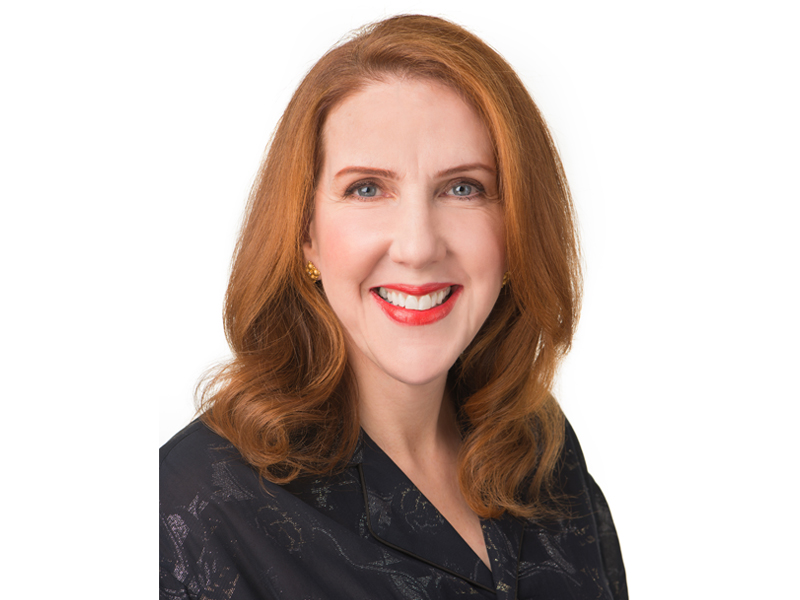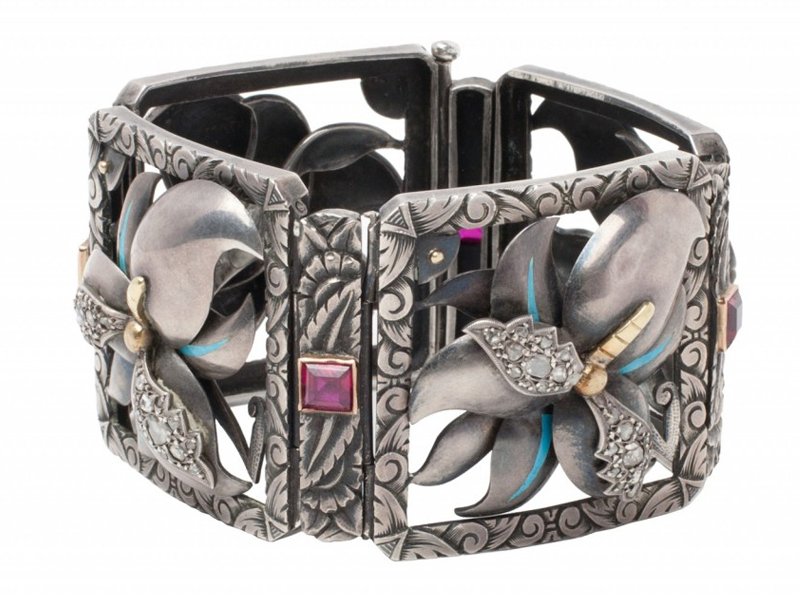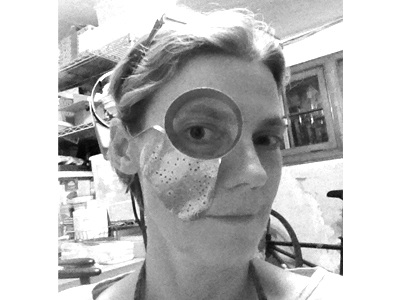
I met Sharon Berman during my first Art Jewelry Forum trip to Amsterdam in October 2013. I noticed her beautiful estate jewelry and she shared with me stories of the pieces she collects. Two AJF trips later, to Estonia/Sweden and Barcelona, I discovered what a passionate jewelry collector Sharon is, and recently learned she is studying for her GIA Graduate Gemology diploma.
Berman is a principal at Berbay Marketing & Public Relations, a Los Angeles firm providing multiple services including advertising, marketing, and PR. Recently she expanded the firm’s reach to include professionals in jewelry and the decorative arts. Berbay Marketing & Public Relations is a corporate sponsor of AJF. Sharon is an AJF board member and the head of AJF’s Marketing Committee.
Adriana G. Radulescu: How did you become a jewelry collector?
Sharon Berman: About 15 years ago, I became enamored with Judith Ripka’s jewelry. This was years before she had a store in Los Angeles, and I had never heard of her before. I saw an advertisement featuring her bracelets and was dazzled. I love her iconic piece, pearls that can be restrung different ways so it can be two necklaces or a bracelet. That’s where I started.
My good friend and now “jewelry buddy” encouraged me to look at antique and estate jewelry, and we started going to shows. It grew from there.
What kind of jewelry have you been collecting?
Sharon Berman: When I first met Susan Cummins, she asked me what kind of jewelry I collect, and I told her I just collect everything. But she said that if she looked at my jewelry she would be able to tell what I collect. Now I realize that, yes, it’s true: I collect very sculptural things. They have to be unusual and one-of-a-kind. I am drawn to masters no one has heard of but should have.
My pieces usually do not include gems or stones. It is the design that makes them striking, not the colors. A beautiful emerald or sapphire can be gorgeous, but where is the artistry in sticking a stone on a ring?
How did your collection develop?
Sharon Berman: My collection is constantly developing as I go to antique and estate jewelry shows, and as I travel. I’m looking for what is unusual. At this point, I have seen so much that when I go to the shows, a lot of it hits me as run-of-the-mill, whether it’s Victorian or avant-garde—when you’ve looked at a lot, you’re trying to surface the unusual.
Is there an overlap between collecting estate jewelry and contemporary jewelry?
Sharon Berman: Estate jewelry crosses all boundaries. Estate jewelry just means that it has been pre-owned. It can be antique or art jewelry. Everything is ultimately a subset of estate.
Does the history of an estate piece affect your appreciation of it?
Sharon Berman: Without question. I recently saw a striking ring done by a master jeweler—someone I’d never heard of during his lifetime, so I know he designed it and probably made it himself. The company bearing his name still exists, but makes very ordinary jewelry today. The ring’s history drew me in.
When you wear a piece from your collection, does it stir memories of the place you saw it, its maker, and the circumstances of your acquisition?
Sharon Berman: Absolutely. Finding interesting jewelry just adds to my passion for travel. I guess that’s why I rarely, rarely, walk into a store and look at “regular jewelry.” Even at Neiman Marcus or Barneys, I may “oooh” and “ahhh” over the jewelry, but to me that’s not a reason to buy it. There is no experience related to it.
You seem very interested in bracelets. Is this your favorite jewelry type, and why?
Sharon Berman: I am drawn to bracelets. A jewelry saleswoman once said to me, “No wonder you like bracelets. You have a long forearm.” Who knows if there’s any truth to that, but it made me think. But really, I just like big bracelets. There is something very chic and elegant about them.

What is your favorite, piece and why?
Sharon Berman: That’s an interesting question. I have a Catalan Art Deco bracelet that is so intriguing to me, and not just because I like the design. It also opened up a whole new area to me. Who ever knew that genre existed? It drew me in and I started learning about the period, the artisans, and some of the history of an area that I knew nothing about before.
What sources do you use to stay informed about the jewelry world?
Sharon Berman: I read a lot. Of course there is Art Jewelry Forum, the newsletter and website. I go to a lot of shows and conferences, such as the Society of North American Goldsmiths. I’m a member of the Association for the Study of Jewelry and Related Arts, The American Society of Jewelry Historians, and the Society of Jewellery Historians in the UK. I am always looking for interesting events, conferences, and seminars in terms of jewelry groups.
I subscribe to JCK and INSTORE magazines, which are for jewelry retailers. I enjoy reading them because I like to think about how I can apply the marketing ideas to other areas.
How did you find out about Art Jewelry Forum, and what made you join the supporters of the group?
Sharon Berman: I was following a jewelry trail on Google, which led me to Art Jewelry Forum’s website. As soon as I saw that the group travels, I said, “Sign me up!”
Your company, Berbay Marketing & Public Relations, recently became a sponsor of Art Jewelry Forum. What inspired this decision?
Sharon Berman: My company decided to be an Art Jewelry Forum sponsor because we are expanding our work to include professionals who work in jewelry and the decorative arts—appraisers, gallerists, dealers, and others.
You recently took gemology courses. Does this added knowledge affect your choices for collection?
Sharon Berman: When I first started getting involved in jewelry, the credential that everybody seemed to have was GG, a Graduate Gemologist, through the Gemological Institute of America. My husband also encouraged me because he believes the more credentials you have, the better. I have a ways to go, but what I am learning is extremely interesting.
Last summer, I took the week-long diamond grading lab. I haven’t used a microscope since eighth grade, and we spent the week examining and measuring diamonds under a microscope. It was eye opening in so many ways!
Knowing more about stones affects my collecting in the opposite sense of what one would think: I have become much more accepting of imitation or treated stones. If it’s beautiful, it doesn’t have to be a natural, untreated stone. That’s just the way the world is. Unless one can afford to spend hundreds of thousands of dollars.
How do you see your collection evolving in the future?
Sharon Berman: The hot word now is curating. For me it works like this: those bracelets were great three years ago, but I’ve really moved on; they are not really unusual, they are run-of-the-mill. I see my collection more evolving to being just the pieces I get more and more focused on. Unusual pieces. One-of-a-kind pieces. Pieces that have a story. Pieces that I’m not going to see anywhere else, that are distinctive. I see some of the pieces I have falling by the wayside. I’m becoming more focused as my tastes evolve and refine.
What inspired you to launch ArtsandJewelry.com?
One of my goals for the website is to reduce the barriers between the different jewelry groups so that everyone can learn from each other and the information is well shared. I want to cover a range of areas, from art jewelry to decorative arts to antique jewelry, so that people can learn about and relate to these other worlds.
Also, I have heard so many interesting speakers at the conferences I attend. I want to broaden the exposure they get as well as deliver this content to people all over the world, not just to those who can travel to a conference.
Thank you!




